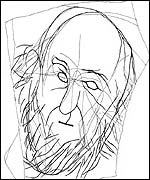BBC News
28 May 2002
Faces from the Ice Age

By Dr David Whitehouse
BBC News Online science editor
What could be the oldest lifelike drawings of human faces have been uncovered in a cave in southern France.
The images were first recognised over 50 years ago, but were then lost after doubts were cast on their authenticity.
Now, one German scientist, Dr Michael Rappenglueck, of Munich University, says it is time the pictures were reassessed.
And there could be other surprises awaiting archaeologists, he believes, when they look not at the walls of prehistoric painted caves, but at the floor.
Extraordinary wonders
The faces on this page were discovered carved on the floor of a cave at La Marche in the Lussac-les-Chateaux area of France.
The cave system was discovered in 1937 by French scientist Leon Pencard, who excavated it for five years. Over 1,500 slabs were found on which images were etched.
The pictures are difficult to interpret. Sometimes several images are superimposed on one another. But to the trained and expectant eye they reveal extraordinary wonders.
From the La Marche caves there are lions, bears, antelope, horses - and 155 lifelike human figures.
These images of "real people" - male and female faces, people in robes, hats and boots - may date back 15,000 years. This was long before the rise of the great civilisations and a time when Europe was firmly in the grip of an Ice Age.
If correct, this would make them far older, for example, than the symbolic face recently recognised, carved into a rock at Stonehenge.
Hidden treasures

"They have been completely overlooked by modern science," Dr Rappenglueck told BBC News Online. "They were mentioned in a few books many decades ago and dismissed as fakes - and since then nothing."
The portraits were carved into limestone slabs that were then carefully placed on the floor.
The illustrations are not the stick-like figures seen in prehistoric cave paintings -- such as the images in the more famous Lascaux cave system that probably date back 17,000 years; or at Chauvet that go back more than 30,000 years.
However, it has sometimes been asked why the animals painted on the walls of such caves are so much more lifelike than the human forms depicted with them.
Could it be because the more sophisticated human pictures were placed on the floor, asks Dr Rappenglueck?
If so, such treasures on the floors of other prehistoric caves may have been accidentally destroyed.
One of the first things that archaeologists used to do when examining such caves was to level and strengthen the floor, not thinking that what was under their feet could be just as significant as what was on the cave walls.
In Lascaux, for example, the floor was obliterated to make way for visitors in the 1950s. There is no way of knowing if anything significant was destroyed.
Stars in the ground
Dr Rappenglueck speculates that many archaeological wonders could have been covered up.

"On the floors of one cave I noticed a series of pits arranged in the shape of the Pleiades (also known as the Seven Sisters) star cluster," he said.
Drawings of the Pleiades have been found by Dr Rappenglueck on the walls of many Neolithic caves in several parts of Europe, but until now no cosmic marks had been found on cave floors.
He speculates that the small holes could have been filled with animal fat and set alight mimicking the flickering stars in the sky.
"Perhaps this is the origin of the candlelit festivals of the Far East where lighted candles are held in the shape of the Pleiades. Perhaps it is a tradition that stretches back tens of thousands of years into our Stone Age past."